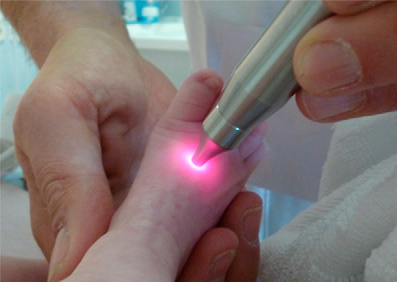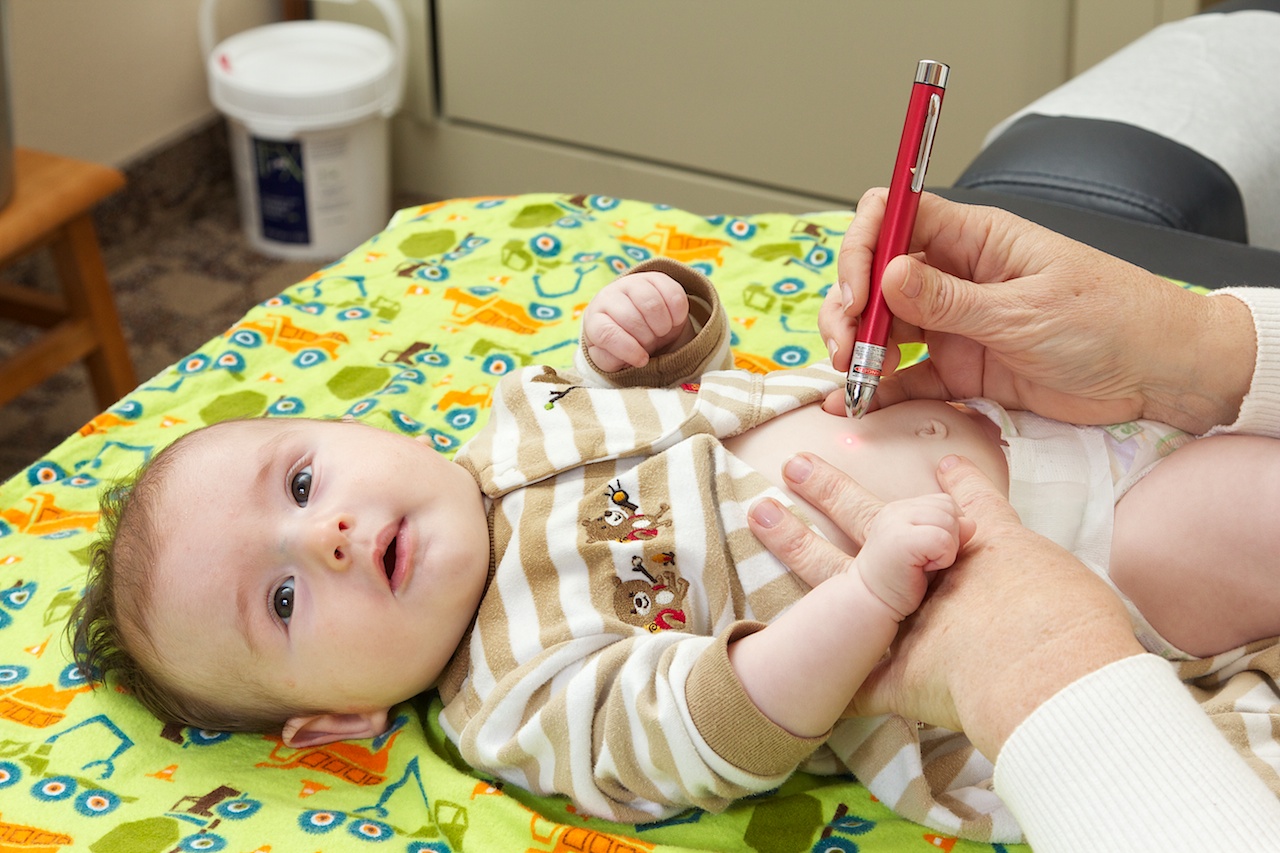As anyone who has been reading this blog knows, I have an affinity for anything that is non-invasive and improves the care of newborns. Add to this my interest in Neonatal Abstinence (which has been the focus of other pieces such as Long term cognitive deficits in infants exposed to in-utero opioids and polysubstance use. In a rare finding, girls may have worse outcomes.) and a recent report of laser acupuncture for adjuvant treatment of neonatal abstinence syndrome would have to pique my interest. In 2014 a case report entitled Laser acupuncture as an adjuvant therapy for a neonate with neonatal abstinence syndrome (NAS) due to maternal substitution therapy: additional value of acupuncture. was published by Raith. I recall seeing this paper prior to starting this blog and Facebook page and made a mental note to check it out someday. That someday is upon me now that an RCT has been published on the subject which will be looked at below.
What is laser acupuncture?
Before we get into critiquing such a study it is worth explaining what laser acupuncture is. From the website acupuncture today I found the following background:
“In 1991, a study was done in Novosibirsk, Russia that applied directly to the study of acupuncture. Researchers shined light on various parts of the body and found that light traveled under the skin to other acupuncture points, but it didn’t travel to places that were not on acupuncture meridians. It appears that the body contains a sort of fiber optic network—where light enters an acupuncture point, travels through the meridian and can be detected at other places along the meridian with a sensitive photon detector. This is a fascinating study showing how light is actually received, used and transmitted throughout the body.”
The RCT in question above is another paper by Raith W et al Laser Acupuncture for Neonatal Abstinence Syndrome: A Randomized Controlled Trial.
This study compared patients receiving treatment for NAS with morphine and phenobarbital and compared 14 in each group on a blinded fashion to laser acupuncture or nothing in addition to the standard regimen. They avoided the need for a placebo in that the intervention was done by the health care provider and then a separate person calculated a pain score who was blind to whether the laser had been provided or not. By blinding the people scoring they hoped to address the criticism that would be present had the study been unblinded. The acupuncture was performed daily at five ear and four body points bilaterally with the primary outcome being duration of oral opiate use.  The authors found a reduction in days of opiate treatment but being a small study it would be considered a pilot at best. The results were 28 days (22 to 33) vs 39 days (32 to 48), respectively, P =.019 and the authors make a comment that phenobarb levels were similar between the groups as well but with overall shorter lengths of stay of 35 days (25 to 47) vs 50 days (36 to 56), respectively, P = .048. There are several issues with the study though and they are as follows. Yes, the light therapy was provided behind a closed door but how do we know that the providers truly kept it a secret during the whole stay of the patient? What medications were the mothers taking and at what doses and for what duration? Was the exposure between groups really the same? Also there was no standard means of weaning that I can see so how do we know by chance that the difference is simply who was on at the time with respect to physician deciding on aggressiveness of weaning. Another issue is that women on replacement medications such as methadone or suboxone were excluded as were women with polysubstance abuse. How close to our patient population really were these patients? Lastly, nearly significant was a preponderance of males in the conventional group and we all know how males generally do compared to females in most studies. Nonetheless it is a exciting study to imagine an effect from and that is what the authors I think were banking on.
The authors found a reduction in days of opiate treatment but being a small study it would be considered a pilot at best. The results were 28 days (22 to 33) vs 39 days (32 to 48), respectively, P =.019 and the authors make a comment that phenobarb levels were similar between the groups as well but with overall shorter lengths of stay of 35 days (25 to 47) vs 50 days (36 to 56), respectively, P = .048. There are several issues with the study though and they are as follows. Yes, the light therapy was provided behind a closed door but how do we know that the providers truly kept it a secret during the whole stay of the patient? What medications were the mothers taking and at what doses and for what duration? Was the exposure between groups really the same? Also there was no standard means of weaning that I can see so how do we know by chance that the difference is simply who was on at the time with respect to physician deciding on aggressiveness of weaning. Another issue is that women on replacement medications such as methadone or suboxone were excluded as were women with polysubstance abuse. How close to our patient population really were these patients? Lastly, nearly significant was a preponderance of males in the conventional group and we all know how males generally do compared to females in most studies. Nonetheless it is a exciting study to imagine an effect from and that is what the authors I think were banking on.
What about laser acupuncture for treatment of pain?
One other study comparing sucrose to laser acupuncture for prevention of pain with heel lances. In this study of 42 infants randomized to the intervention or sucrose the authors concluded that sucrose was superior to acupuncture for managing pain from heel lancing. This study did not have a third arm in which no treatment was given (likely due to it being unethical) so what we can’t say for sure is whether laser is better than nothing.
Personally I find a bit of a leap to believe that shining a light through the skin would have an effect on pain perception by anyone. I can certainly understand the concept of putting a needle into tissue or applying pressure no different from the effect of rubbing ones temples when they have a headache (works for me at least). The Chemistry major in me though has trouble with the effect of photons passing through tissue even if directed at acupuncture points. Having said that the only positive thing I can say is that a quick search for such instruments shows them to be commercially available and as cheap as $50 or so. I have no doubt there are people who will read this RCT and be impressed with its additional purported impact on NAS and thankfully if they do decide to pursue this intervention they will not have spent a fortune on it. Money in health care should be directed to what works to help patients and the skeptic in me just isn’t buying this even if it appeals to my curiosity with non-invasive strategies.

